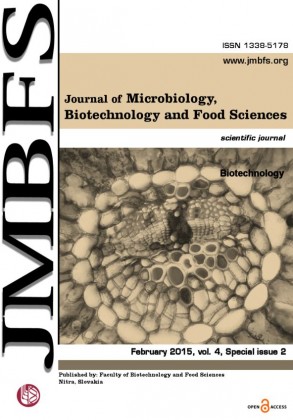THE DIFFERENCES BETWEEN THE OLD AND NEW BARLEY VARIETIES ON THE BASIS OF HORDEIN POLYMORPHISM WITH RESPECT TO QUALITATIVE PARAMETERS
DOI:
https://doi.org/10.15414/jmbfs.2015.4.special2.108-110Keywords:
Barley, hordeins, polymorphism, protein markersAbstract
The current registered barley varieties are classified according to their biological and economic characters meeting the growing conditions. Varieties are characterized using molecular markers on the level of protein and DNA. Using starch gel electrophoresis we studied the frequency of hordein alleles, which are potential markers of economically important traits of 30 barley varieties. Among the 26 alleles detected in two main loci (Hrd A, Hrd B), we identified 7 potential markers (A3, A12, A23, B8, B17, B19, B47) with the frequency ranged from 1.18% to 12.14%. Number of these alleles differs over the years and together with number of lines per variety has decreasing tendency. On the basis of the detected alleles we are able to predict malting quality parameters and resistance to most common barley pathogens.Downloads
Download data is not yet available.
Downloads
Published
2015-02-02
How to Cite
Tomka, M., Chňapek, M., Gálová, Z., & Urminská, D. (2015). THE DIFFERENCES BETWEEN THE OLD AND NEW BARLEY VARIETIES ON THE BASIS OF HORDEIN POLYMORPHISM WITH RESPECT TO QUALITATIVE PARAMETERS. Journal of Microbiology, Biotechnology and Food Sciences, 4(special issue 2 (Biotechnology), 108–110. https://doi.org/10.15414/jmbfs.2015.4.special2.108-110
Issue
Section
Biotechnology
License
Copyright (c) 2015 Marián Tomka, Milan, Chňapek, Zdenka Gálová, Dana Urminská

This work is licensed under a Creative Commons Attribution 4.0 International License.
All papers published in the Journal of Microbiology, Biotechnology and Food Sciences are published under a CC-BY licence (CC-BY 4.0). Published materials can be shared (copy and redistribute the material in any medium or format) and adapted (remix, transform, and build upon the material for any purpose, even commercially) with specifying the author(s).





